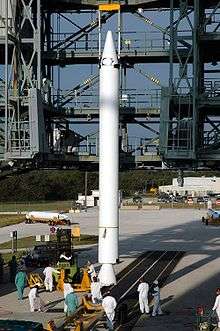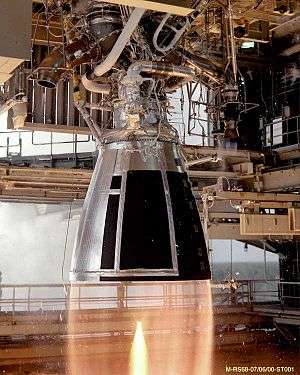Graphite-Epoxy Motor
The Graphite-Epoxy Motor (GEM) is a series of solid rocket boosters fueled by HTPB and produced by Northrop Grumman Innovation Systems with a carbon-fiber-reinforced polymer casing.[1] GEM series boosters were previously used on the Delta II, Delta III, and Delta IV. They will fly on Atlas V, Vulcan, and the proposed OmegA.
 A Delta IV M 4,2+ launching with two GEM-60 solid motors. | |
| Manufacturer | Alliant Techsystems Orbital ATK Northrop Grumman Innovation Systems |
|---|---|
| Country of origin | United States |
| Used on | Delta II, Delta III, Delta IV, Atlas V (future), Vulcan (future), OmegA (future) |
| Launch history | |
| Status | Active |
Active variants
GEM-63
The GEM-63 is being developed as a drop-in replacement for the Aerojet Rocketdyne AJ-60A booster used on the Atlas V. The Atlas V will begin flying with the GEM-63 in 2020 with the STP-3 launch.[2]
Version comparison
| Name | Application | Length | Diameter | Gross mass | Propellant mass | Thrust | Specific impulse | Burn time | Fuel |
|---|---|---|---|---|---|---|---|---|---|
| GEM-40 | Delta II | 11.40 m (449 in) | 1.016 m (40.0 in) | 13,005 kg (28,671 lb) | 11,767 kg (25,942 lb) | 499 kN (112,200 lbf) | 245 s (SL) 283 s (air-lit) [6] |
63 sec | HTPB |
| GEM-46 | Delta III, Delta II | 12.573 m (495.0 in) | 1.1684 m (46.00 in) | 19,140 kg (42,196 lb) | 16,860 kg (37,180 lb) | 601 kN (135,200 lbf) | 242 s (SL) 284 s (air-lit) [7] |
77 sec | HTPB |
| GEM-60 | Delta IV M+ | 13.2 m (518 in) | 1.5 m (60 in) | 33,638 kg (74,158 lb) | 29,697 kg (65,471 lb) | 879 kN (197,500 lbf) | 245 s (SL) | 91 sec | HTPB |
| GEM-63[8][9] | Atlas V | 20.1 m (792 in) | 1.6 m (63 in) | 49,300 kg (108,600 lb) | 44,200 kg (97,500 lb) | 1,663 kN (373,800 lbf) | 94 sec | HTPB | |
| GEM-63XL[8][9] | Vulcan, OmegA | 22.0 m (865 in) | 1.6 m (63 in) | 53,400 kg (117,700 lb) | 48,000 kg (105,800 lb) | 2,026 kN (455,400 lbf) | 84 sec | HTPB | |
Retired variants
GEM-40

The GEM-40 is a 40-inch-diameter (1,000 mm) SRM used on Delta II beginning in 1990. The use of composite materials allowed for booster casings lighter than the steel casings of the Castor 4 SRMs they replaced.[10] The first flight of a GEM-40 occurred in 1990 on a Delta II 7925.[11] Delta II vehicles can use three, four, or nine GEM-40s. When using three or four boosters, all GEM-40s ignite on the ground, while on Delta IIs using nine boosters six are ignited on the ground, and the remaining three are ignited in the air when the first six burn out.[12]
Failures
On August 5, 1995, an air-lit GEM-40 failed to separate from a Delta II 7925 carrying Koreasat 1. The excess mass of the booster resulted in the satellite reaching a lower than intended transfer orbit, which it was able to compensate for using on-board propellant.[13]
On January 17, 1997, a Delta II (Delta 241) exploded due to a catastrophic failure in a GEM-40. The failure triggered the launch vehicle's self-destruct function 13 seconds after ignition. An Air Force investigation determined that the motor's casing had been damaged prior to launch, resulting in the casing splitting open soon after ignition.[13]
GEM-46
The GEM-46 was a lengthened 46-inch-diameter (1,200 mm) solid motor originally developed for Delta III. This solid motor variant also included thrust vector control (TVC) to help steer the vehicle. After the discontinuation of the Delta III, GEM-46 motors (without TVC)[12] were used on the Delta II to create the Delta II Heavy, which could only be launched from a modified pad at Cape Canaveral.[14] Both Delta III and Delta II-Heavy used nine GEM-46s, with six ignited on the ground and three air-lit.[15][16]
GEM-60
The GEM-60 was a 60-inch-diameter (1,500 mm) solid motor used on the Delta IV family of launch vehicles, available with and without Thrust Vector Control (TVC).[12] A Delta IV Medium+ can use two or four GEM-60s,[17] and was retired after the launch of a GPS-III satellite which launched on 22 August 2019.[18]
See also
References
- "Northrop Grumman GEM Capabilities". Northrop Grumman.
- @NASASpaceflight (5 September 2018). "Sept. 20: Northrop Grumman is inviting media to watch a qualification ground test of the Graphite Epoxy Motor (GEM 63) that will be used as strap-on boosters on the Atlas V rocket beginning July 2019 with the STP-3 mission that will utilize five boosters. 😎" (Tweet) – via Twitter.
- "Orbital ATK beats out Aerojet". Retrieved September 23, 2015.
- Tory Bruno [@torybruno] (3 April 2018). "About 5 ft (eXtra Long)" (Tweet) – via Twitter.
- Tory Bruno [@torybruno] (3 April 2018). "Higher performance. Approaching half the cost" (Tweet) – via Twitter.
- "GEM 40". Astronautix.com. Archived from the original on 10 January 2017. Retrieved 24 July 2014.
- "GEM 46". Astronautix.com. Archived from the original on 5 March 2016. Retrieved 24 July 2014.
- "GEM 63/GEM 63XL Fact Sheet" (PDF). Northrop Grumman. 5 April 2016. Archived from the original (PDF) on 18 September 2018. Retrieved 18 September 2018.
- "Developing Vulcan Centaur" (PDF). 8 April 2019. Archived from the original (PDF) on 25 August 2019. Retrieved 24 August 2019.
- "Launch Vehicle: Solid Rocket Motors". JPL. Retrieved July 24, 2014.
- "GEM 40". Astronautix. Archived from the original on January 10, 2017. Retrieved July 24, 2014.
- "ATK Product Catalog" (PDF). ATK. Archived from the original (PDF) on July 30, 2018. Retrieved July 24, 2014.
- "Delta 2 Productive Years". Space Launch Report. Retrieved July 24, 2014.
- "ULA Delta II successfully lofts OCO-2 to orbit". NASASpaceflight.com. Retrieved July 22, 2014.
- "Delta II 7920H-10". Spaceflight 101. Archived from the original on 2014-07-14. Retrieved July 24, 2014.
- "Delta III Data Sheet". Space Launch Report. Retrieved July 24, 2014.
- "Delta IV Medium+ (4,2)". Spaceflight 101. Retrieved July 24, 2014.
- Ray, Justin (4 March 2015). "Could Delta rockets soon be a thing of the past?". Spaceflight Now. Retrieved 8 December 2016.
